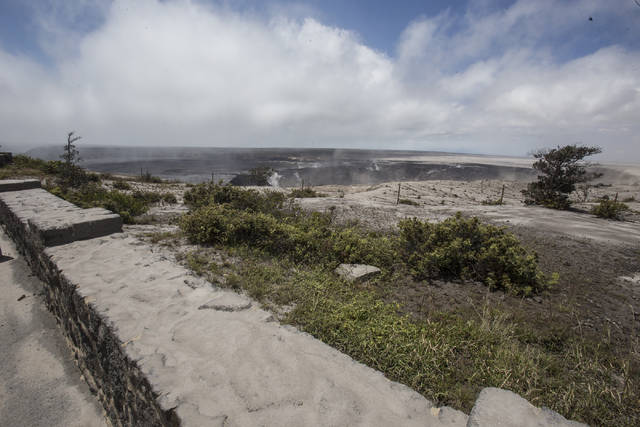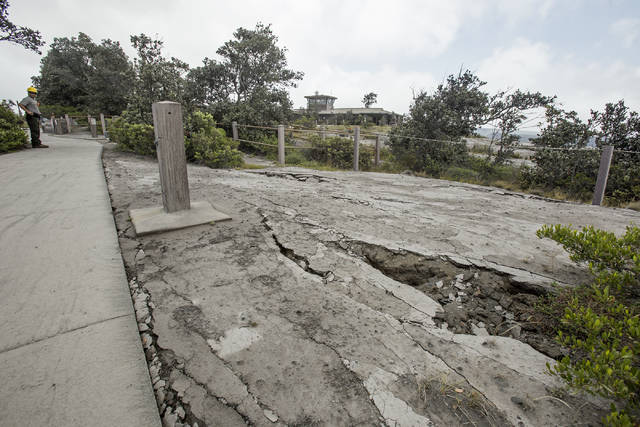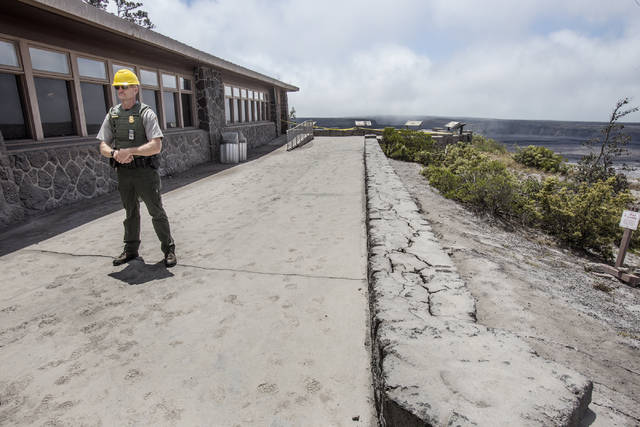With no visitors to gaze in awe at its splendor, Kilauea caldera is often shrouded in a peaceful, though deceptive, silence.
Wisps of gas and dust rise out of the ever-growing Halema‘uma‘u crater, now double in size from only two months ago, and white-tailed tropic birds, which make homes in its cliffside, glide above its edge.
But the stillness seen Thursday morning during a media tour of the summit was merely an interval in a dynamic process that continues to reshape the volcano, astound scientists and keep Hawaii Volcanoes National Park closed.
“We’re used to looking at changes on the order of centimeters every year,” said Kyle Anderson, a research geophysicist with the Hawaiian Volcano Observatory. These days, geologists are seeing parts of the caldera floor drop as much as 30 feet per day, which he called staggering.
That process is being driven by the withdrawal of magma from the summit that followed the start of the lower East Rift Zone eruption on May 3. To date, that eruption has claimed at least 657 homes.
The loss of molten rock causes Halema‘uma‘u, which sits inside the caldera and until recently was home to a lava lake, to drop like a piston about once a day as it loses the magma chamber that provided it support. These events coincide with a burst of ash, some of which cakes the overlook at Jaggar Museum, and energy that can be equivalent to a magnitude-5 earthquake.
Anderson said the volume of the crater, which has dropped more than 1,300 feet since this process began, is expanding by more than 10 million cubic meters per day.
Tina Neal, HVO scientist-in-charge, said the amount of change being witnessed is unprecedented in modern history.
“But change is what volcanoes do,” she said.
It’s also giving scientists an opportunity to learn more about the volcano as it feeds magma to the lower East Rift Zone.
“It truly is on a personal level pretty mind-blowing, and I have mixed emotions about it,” Neal said. “It really is an inspirational event … And we have so much to learn from this that will help future generations and other volcanologists around the world deal with the same situation. It’s a real mixture of sadness and loss and awe and challenge.”
As the volcano ramps up to the next collapse-driven eruption, smaller quakes, as many as 40 per hour, occur at the summit, while larger temblors have formed narrow cracks that meander from the overlook wall to the museum and stretch across the visitor parking lot.
These hazards keep most of the park closed — only the Kahuku unit remains open — and officials say they don’t know when the main park area, one of Hawaii Island’s main attractions and economic drivers, will be safe to welcome visitors again. But they do know it won’t look the same.
“It’s like a hurricane that’s not over,” said Ben Hayes, the park’s chief of interpretation. “If you look at the amount of damage being sustained, we’re looking at a very lengthy recovery time.”
The park has been closed since May 11, making it the longest closure in the park’s history.
Rhonda Loh, park natural resource chief, said a full assessment of the damage to roads and facilities can’t be done until the activity of the summit stabilizes.
“We’re really wanting to see, to hear, from the scientists, the (U.S. Geological Survey) scientists, when things have entered a new phase, when conditions have changed, and then, at that point, we could be starting to look at a recovery and what will need to be done … to reopen the park safely,” she said.
While geologists don’t expect the Jaggar Museum and HVO building to fall into the caldera, Loh said it also won’t be known if those facilities can be reused until a structural assessment is done.
“We don’t know,” Loh said, when asked if Jaggar will reopen someday. “We really don’t know until we can do those assessments. It’s a lot of speculation.”
The closure hasn’t stopped people from trying to see the volcano.
John Broward, the park’s chief ranger, said about two people a day are stopped in the park, with about 30 citations issued so far.
He said people walk in through side trails or through the re-established Chain of Craters Road.
Anderson said they also don’t know when these collapse-driven eruptions will stop.
He said they likely will continue as long as more magma is leaving the summit than being supplied to it.
Anderson noted the collapses at the summit could outlast the lower Puna eruption since magma might be getting stored somewhere in the rift zone, in addition to feeding the fissures. And when the lower Puna eruption will stop remains anyone’s guess.
But the data scientists are gathering now will be used for years to come and continue to help them fine-tune their predictions that could help save lives.
Anderson said they already are changing the way they think about these explosive events. For instance, he said groundwater intrusion is no longer thought to be a significant contributor to the eruptions.
“The measurements we are now making will inform scientific studies for generations and I think will tremendously improve our understanding of these systems,” Anderson said.
“I think people will be talking about this and writing about this for generations.”
Email Tom Callis at tcallis@hawaiitribune-herald.com.











